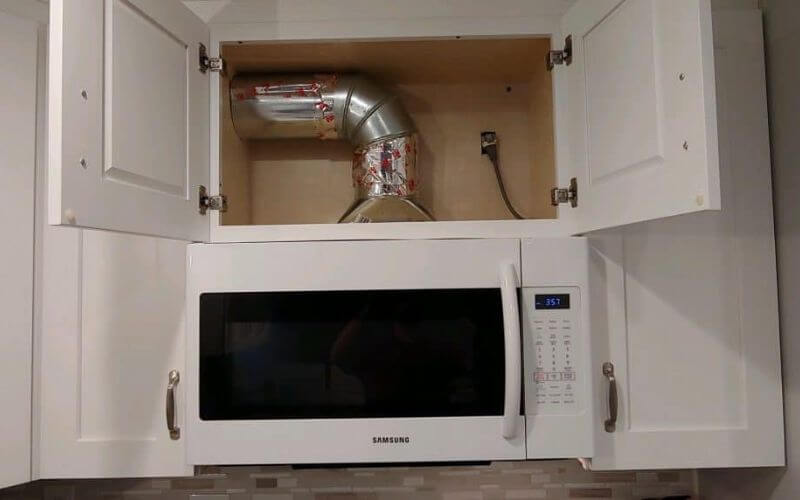Modern kitchens try to maximize available space. This entails keeping your kitchen clean by separating your appliances, including your microwave, into different rooms. However, this may jeopardize the device’s efficient functionality.
To function correctly, a microwave oven requires adequate ventilation and free space. However, the degree of clearance and ventilation required varies greatly depending on the type of microwave model. Some may require external ventilation, while others may require adequate space.
Table of Contents
ToggleThese machines produce a lot of heat. As a result, it stands to reason that ventilation is required. We also enlist feedback from various experts to explain why ventilation is so important. Continue reading this article.
Venting Out Microwaves?
The microwave oven requires ventilation to function properly. As a result, ensure that the room you use has adequate ventilation. In addition, some microwave ovens have built-in ventilation systems, but the majority do not. Insufficient ventilation reduces efficiency. Furthermore, it may result in bugs or, worse, irreversible damage.
Clogged vents can also cause serious problems. It can cause overheating and even a fire. Now that you understand why ventilation is so important let’s look at how various types of microwave ovens are ventilated. Please keep in mind that other models require additional instructions. As a result, always read the user manual for your device.
What Is The Purpose Of Ventilation In Microwave Ovens?
As we all know that ventilation is required for microwave ovens to operate efficiently and safely in the kitchen. However, the amount of airflow needed varies depending on the model and finish. On the other hand, all microwave ovens without built-in systems should have adequate external ventilation.
To begin, you must understand how to generate heat to cook your food. They use radiation to accomplish this. When food particles and water are heated, they vibrate and cook. The air inside the oven expands as the food cooks. And that air must get out so the microwave doesn’t overheat. Check for adequate airflow through external ventilation. This is done to ensure that the exhaust does not enter the house.
Finally, the instruction manual includes a list of the minimum requirements. To ensure proper ventilation and clearances, follow these guidelines.
Why Do Tabletop Microwave Ovens Need Ventilation?
Microwaves, as we all know, require ventilation. Countertop microwave ovens, on the other hand, do not require external ventilation.
It is designed to stand on your kitchen worktop, unlike microwave ovens. There are vents on the top, sides, and back, so your job is to ensure that no obstacles are nearby. Keep it out of the reach of children and pets just in case. Be careful because it gets hot quickly.
Do Over-The-Range Microwave Ovens Necessitate Ventilation?
Internal ventilation is provided by OTR (Over the Range) microwave ovens. Adding external ventilation is thus optional. These are microwave ovens that are built into the top of your stove. They have been observed perching on kitchen walls and hiding in cupboards. And in comparison to other microwaves, it has a low carbon footprint.
The OTR microwave also has an integrated ventilation system and an internal exhaust fan to aid in proper airflow. It can also be linked to an outdoor vent to exhaust smoke, steam, and odors outside your home. This one has the best ventilation system among all microwave oven design series. To maximize efficiency, you don’t need much.
Do Convective Microwaves Need To Be Ventilated?
The simple answer is no. This is because these microwave ovens use fans to circulate the air within the unit. Convection microwaves, like OTR microwaves, use internal fans for cooking food faster while also introducing proper airflow. You should, however, have enough free space—there is no need to vent. Please keep in mind that your region may differ. As a result, before making a final decision, it is critical to understand the regulations.
The Ventilation System’s Effectiveness
The exhaust will be vented outside if the microwave is connected to the external exhaust port. This includes keeping your kitchen free of the smoke, steam, and odors associated with microwave use. On the other hand, internal vents filter the same exhaust gases through a charcoal-like material filter—this aids in removing odors and small particles. The air, however, is returned to the kitchen.
Both systems have benefits and drawbacks. So, figure out what works best for you and what complies with local regulations. Installing an exterior vent in your home takes a lot of effort. It must adhere to design standards while meeting the manufacturer’s standards.
A microwave oven with an internal ventilation system eliminates the need for this concern. It can be placed anywhere there is adequate ventilation. They are completely flexible and inexpensive to handle, unlike external vents. The only thing you need to be concerned about is the filters. They will become less efficient if they are not cleaned and replaced regularly.
We recommend using an aluminum filter if you choose a microwave oven with an internal circulation system. They can be washed and reused, unlike activated carbon filters, and thus last longer.
Also, check Bathroom Vent Fan Dripping Water – What To Do?
Poor Ventilation Hazard
As mentioned in this article, poor ventilation poses significant risks and hazards. Not only is your microwave oven affected, but so is your entire house.
You risk overheating your machine if proper ventilation is not provided. This will deteriorate over time and impair performance. The most serious issue, however, is that this can result in house fires.
Even if your microwave has enough space, placing anything over the vent is enough to cause an accident. It can obstruct and obstruct proper airflow. Another issue to consider is insufficient spacing. Squeezing a microwave into a small space causes extensive damage.
Most of the time, burn marks are left on the walls and shelves. Inadequate ventilation can also lead to inhaling the microwave oven’s fumes while in use. There are numerous sources of indoor air pollution, but microwave ovens are one of the main culprits. They emit volatile organic compounds, particulates, and carbon dioxide into the atmosphere. These significantly reduce the quality of the indoor air we breathe, negatively impacting our overall health.
Want To Know If A Microwave Needs Ventilation?
proper ventilation is critical for maximizing microwave efficiency. Without them, you risk your machine deteriorating to the point where it no longer works or becomes a hazard in your home.
You can also avoid accidents like burns and house fires by storing them in an open area with no obstacles. Therefore, keep it out of reach of children, pets, and the elderly. Also, be prepared to call a professional at any time in the event of an accident.





















